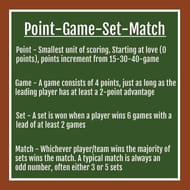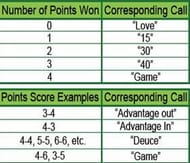The modern version of tennis has some interesting history predating it. Despite the fact that a lot of rules have changed over time, the origin of the scoring system still baffles most tennis historians.
Let's start with the most basic rules in use today:

So we know that four points form a game, six games form a set and winning a majority of sets out of three or five gives you the match.
Any ordinary viewer not particularly interested in tennis, however, might feel that the points system does not make any sense whatsoever. 15-40, deuce? What the hell is going on?

The roots of the point system are largely unknown and intensely debated. The earliest written record of this system dates back to the medieval period around the 16th century.
The main reason for the system is argued to be that the clock faces depict each stage of the development of the game. This would probably explain why it was called 45 before instead of 40. Also, in the initial stages, there was no concept of deuce.
Over time, as the rules changed to only allowing a game win with a two-point difference, the 45 went down to 40 which. That meant on ‘advantage’, the player went to 50, and with one more point the clock hand would go to 60, meaning the ‘game’ was won.
The interesting thing is that during the medieval time, the hour hand (1-12) was still in use, which means that this notation system cannot have originated from the medieval times.
This similar two-point difference applies as we move to the set score as well. We know that it takes six games to win a set, but what happens if the set score is 5-5? If the score is equal at 5, then the first to 7 wins the set.
Makes sense? From there on, there are two ways in which the set can progress:
- Advantage set
An advantage set means that the player must have a two-game difference to win the set. This rule has gone out of fashion in professional tennis except in the final set of the Grand Slam matches (except the US Open, and now also at Wimbledon after 12-12).
The finest example of how daunting this format can get was seen in the John Isner vs Nicholas Mahut Wimbledon match, where the final set itself ran upwards of 8 hours - with a score of 70-68.
- Tiebreak set
The more common alternative is the tiebreak set, which means that after 5-5, if the game extends to 6-6, then the set goes to a tiebreak.
A tiebreak or tiebreaker is almost like a sudden death situation, where the player who first gets to 7 points wins the entire set. If you have been following a pattern by now, you would know that the player will have to maintain a two-point difference if the tiebreak goes to 6-6 or beyond.
These moments tend to be the most exciting moments in tennis due to the buildup of tension and the sheer mental and physical strength required to compete at such a crucial juncture of the game.
A normal match is generally a best-of-three-set match, which means the first to two sets is victorious. On the bigger stages such as Grand Slams, the men's singles has best-of-five-set matches. This add a new level of mental fortitude required to win, which makes sense as the Slams are the biggest stage in the sport.
Although the rules have remained more or less static since the standardization of lawn tennis rules in the 70s, last year the ATP started experimenting with a completely new set of rules introduced at the ATP Next Gen Finals, where the top-ranked players (under 21) of the year compete against each other. The idea was to create a more "high-tempo, cutting edge and TV friendly product".

After extensive market research and fan surveys, the ATP came up with these rule changes:
- First to four games to win a set (tie-break at 3-3)
- No deuce and advantage; four points wins the game
- Shorter warm-up (game starts precisely 5 minutes after the second player walks on court)
- Shot clock (strict 25-second rule between points)
- Fans can move freely during points in the stadium
- No let rule (the ball can touch the net on service and the point continues).
- Player coaching is allowed at certain points of the game. This opens a new dimension in the game.
I for one am very interested in these new rules; they could dramatically change the landscape of how tennis is viewed in the modern world. The analogy I can draw here is what the T20 match style did for infusing a new energy to cricket and attracting fans who might not have seen the game otherwise.
Who knows, the new approach to tennis scoring and rules could well open up the sport to a much bigger fanbase.
